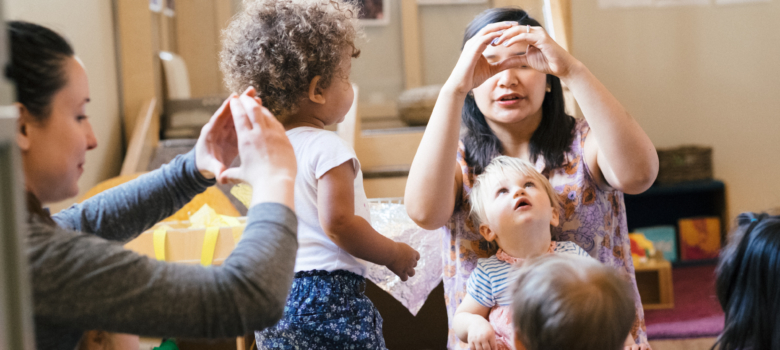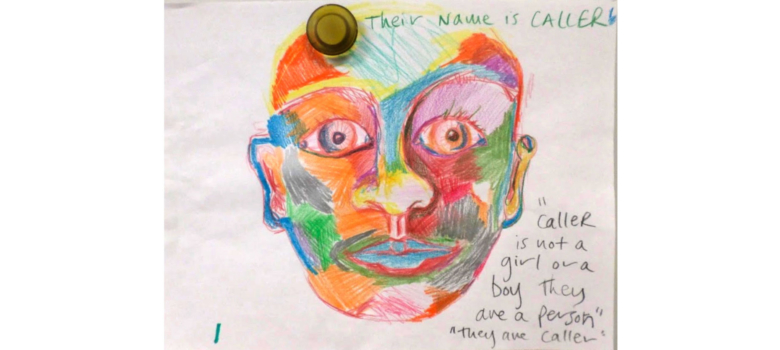by Maia Brown, Infant Toddler Education Program Teacher
At Studio—the UCDS Infant Toddler Education Program—our families speak eight languages including English. Some of our faculty share two of those languages with families, others only one. With such a multilingual community, I wanted to know more about how to support all of the languages in children’s lives and how to create early learning spaces that could expand our preliteracy environments beyond an English-dominant monolingual norm. The more educators, parents, and scholars I talked to, the more excited I became about ways that our school communities could be teaching and learning in deeply multilingual ways. I also realized how high the stakes were.
At a recent staff meeting, Studio faculty mapped our own language histories and discovered that, collectively, our families had spoken over a dozen languages. We also realized that, collectively, we had lost nine of those languages. We wondered together about the shape of that loss and what our responsibilities as educators were, not only to celebrate, but fight to sustain children’s rich linguistic identities.
Scholar, Denise Sullivan articulates the vision this way:
As we move beyond ‘English Only’ practices and policies, we have a responsibility not just to tolerate the use of [home languages], but to create classroom environments where our students’ native languages may flourish; where multilingual and multicultural identities are valued; where the native language is seen as a resource rather than a liability; where English is learned in an additive, rather than a subtractive context and where all children are enabled to meet their personal and academic potentials. Using multilingual strategies to promote home language development is a choice we as educators can make, regardless of our educational context.
What role can we play in supporting children and families to access all of themselves when at school—all of their linguistic resources and heritages? When we do that, the research shows, everyone in our classrooms and communities benefit. I wanted to share some of my research, conversations, and visioning in a format that allows for multiple voices and languages. Here is a version of the podcast that emerged. Enjoy!
Multilingualism In Early Learning Podcast on Soundcloud
Thank you to all of the Studio families who participated in this project, lending their voices, translations and translanguaging skills. Thank you also to Lubna Alzaroo, Dr. Marissa Rollnick, Dr. Sandra Silberstein, as well as Professors Emily Machado and Soojin Oh Park, who spoke with me and shared resources. Gratitude for the music throughout goes to (in order of appearance): Daira Elsa Quinones, Brivele, Kaeley Pruitt-Hamm, Stefanie Brendler, Brian Lindsay, Ariel Gross.
Works Cited:
Ball, Jessica. 2011. 2011. “Enhancing Learning of Children from Diverse Language Backgrounds: Mother Tongue-based Bilingual or Multilingual Education in the Early Years.” United Nations Educational Scientific and Cultural Organization (UNESCO), 1-87.
De Sousa, E. Brook Chapman. “Five Tips for Engaging Multilingual Children in Conversation.” Young Children 74 (2019): 1-18.
Ghiso, Maria Paula. 2013. “Every Language is Special: Promoting Dual Language Learning in Multicultural Primary Schools.” Young Children 68 (1): 22-26.
Lee, Alice Y., & Lara J. Handsfield. 2018. “Code Meshing and Writing Instruction in Multilingual Classrooms” The Reading Teacher 72 (2): 1-10.
Pacheco, Mark B. & Mary E. Miller. 2015. “Making Meaning Through Translanguaging in the Literacy Classroom.” The Reading Teacher 69 (5): 533-537.
Park, Maki & Jie Zong & Jeanne Batalova. 2018. “Growing Superdiversity Among Young U.S. Dual Language Learners and Its Implications.” Migration Policy Institute, 1-47.
Shafer, Leah. 2018. “Multilingual Preschoolers: Young children are increasingly linguistically diverse. How can early childhood educators provide a safe, nurturing environment?” Usable Knowledge: Relevant Research for Today’s Educators. https://www.gse.harvard.edu/news/uk/18/04/multilingual-preschoolers.
Sullivan, Denise. 2011. “Using Multilingual Strategies in Monolingual Early Childhood Classrooms.” Welcoming Linguistic Diversity in Early Childhood Classrooms: Learning from International Schools. Ed. Edna Murphy, 16-27.
Zapata, Angie & Tasha Tropp Laman. 2016. “‘I write to show how beautiful my languages are’: Translingual Writing Instruction in English-Dominant Classrooms.” Language Arts 93 (5): 366-378.


